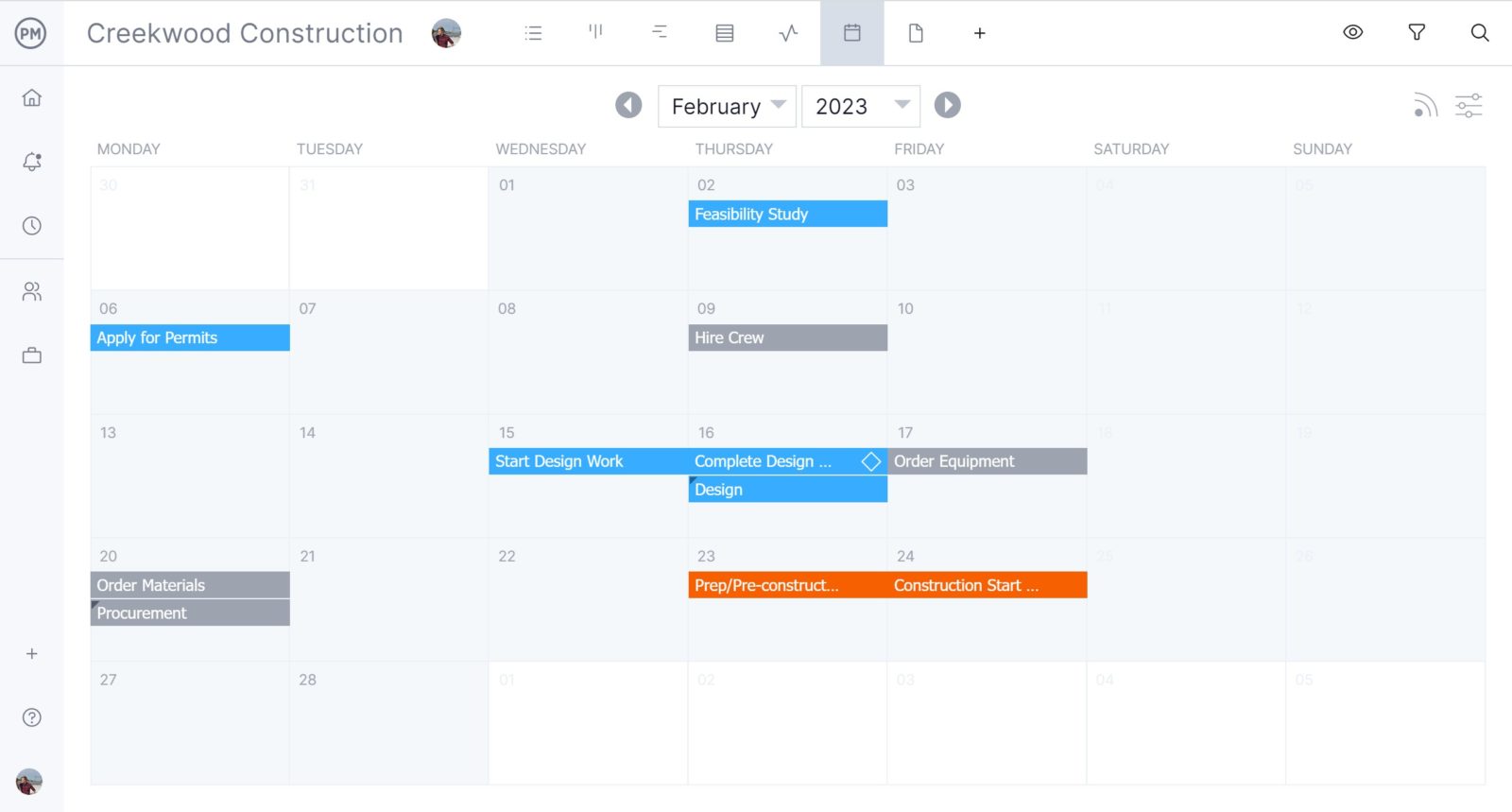Construction delivery methods matter. They are the means by which a construction project gets from idea to completion. That’s a long and complicated journey in construction project management, which is why knowing the best construction delivery method is so important. You can’t reach the end of your project if you’re not sure of the steps to get there, and construction delivery methods outline those steps.
Before we look at the various construction delivery methods, we need to first make sure we’re clear on what a construction delivery method is. We’ll then explore how to choose the right construction delivery method for your organization and project. Finally, we’ll describe some of the more popular construction delivery methods and how construction project management software can help deliver success no matter which construction delivery method you choose.
What Is a Construction Project Delivery Method?
A construction delivery method is a procedure by which a construction project goes from initiation to close. It’s a system for organizing and financing the design, construction, operations and maintenance services for the build on which you’re working, be it in a structure or facility. It’s a legal agreement, like a contract, that’s between different parties involved in the construction project.
There isn’t just one construction delivery method. There are many different types, from design-bid-build, design-build and construction manager at risk to integrated project delivery, job order contracting and public-private partnerships. These are only the most popular construction delivery methods, which we’ll detail in a moment. While there are others, we don’t focus on them because they’re more niche or less used in the industry. These other methods could be worth researching if the ones we highlight aren’t a good fit for your company and work.
Whichever construction delivery method you choose, you’re going to need construction project management software to get the most out of it. ProjectManager is project management software with the features you need to deliver your construction project successfully through every phase of its lifecycle. Our robust Gantt charts help you organize tasks, plan resources and costs, link dependencies, filter for the critical path and set a baseline to monitor project variance and keep your construction project on track. Get started with ProjectManager today for free.
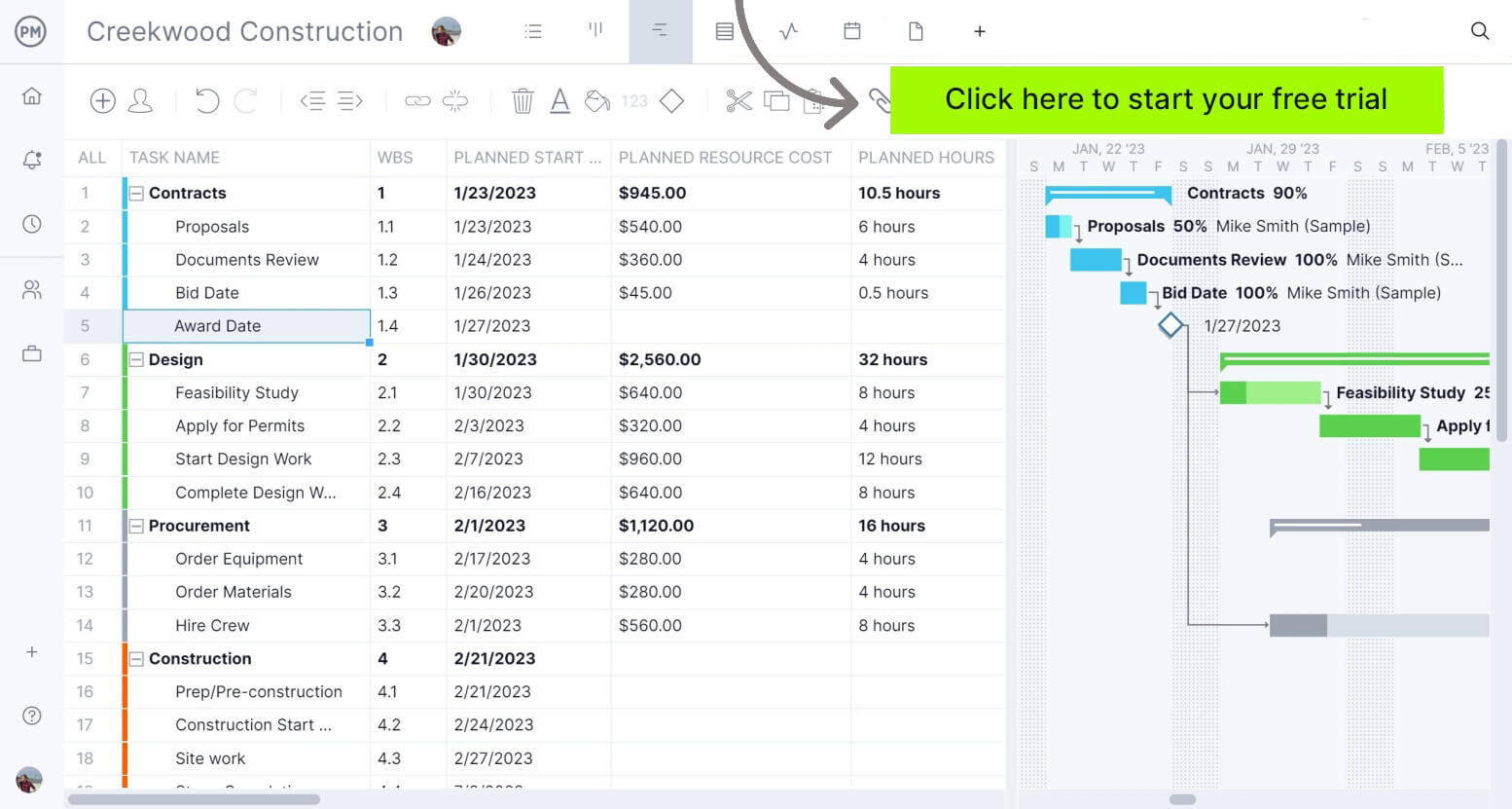
10 Types of Construction Project Delivery Methods
There are many factors to consider when deciding on the construction delivery method that’s best for the project. To make the right choice, you need to know the various construction delivery methods and what they mean. Some will be ideal while others will be easy to dismiss. To know which is right for you and the construction project, it’s imperative to understand the most common construction delivery methods.
1. Design-Bid-Build (DBB)
Design-bid-build or DBB is the sequence of phases in this construction delivery method. It’s also called traditional as it’s the most common. It starts with the selection of an architect who designs the project. This is done before the owner selects a general contractor, which is done through the submission of bids. The last phase is the building of the project. This construction delivery method consists of two contracts, one for the design and the other for the construction.
This construction delivery method is not only common but usually less costly, at least up front. Owners have time to offer feedback about the design before construction begins. At this point, it’s easier and less expensive to make those changes. The drawback of DBB is that there’s no collaboration between design and construction, which can lead to issues. There might be material or technical problems with the design that the general contractor wants to resolve before construction.
Design-Bid-Build Pros
- Allows for competitive bidding which can lead to lower costs
- The owner has significantly more control over the design process as they contract directly with the architect
- The roles and responsibilities of the architect and contractor are clearly defined
Design-Bid-Build Cons
- The sequential nature of DBB can result in a longer project timeline
- The separation between design and construction can lead to disputes between the contractor and the architect
- Less collaboration between the design and the construction teams can lead to less innovative solutions
2. Design-Build (DB)
Gaining popularity is the design-build or DB construction delivery method. It’s more straightforward for owners and tends to reduce risk. However, owners have less input on design, construction management and trade partners than in other construction delivery methods. That’s because, in this method, the design and construction are handled by one firm, so the owner only needs one contract for architecture, engineering and construction.
That doesn’t mean the design and construction firm have carte blanche. Performance requirements are specified by the owner in the contract. That will lead to fewer change orders as the design construction firm will be in close collaboration, saving costs, speeding up the delivery of the project and avoiding potential litigation. The owner is still giving up a great deal of control in this construction delivery method. The onerous is on the owner to do the research when selecting the firm to make sure they’re a good fit and detailing what they want in the contract.
Design-Build Pros
- The integration of design and construction phases can significantly reduce the overall project timeline
- The design-builder assumes responsibility for both construction and design which reduces the owner’s risk
- The owner has a single point of contact for the whole project which simplifies communication and management
Design-Build Cons
- The owner is working with a single entity that handles design and construction, meaning they have less direct control over the design process
- There may be less competition among contractors because design and construction are bundled, potentially leading to higher costs
- The owner needs to have a high level of trust in the design builder’s capabilities in both construction and design
3. Construction Manager at Risk (CMAR)
This construction delivery method is popular when owners need a firm deadline and a definite price for the project’s completion. The construction manager is like a consultant to the owner during the design phase of the project. The construction manager selects the subcontractors for the job and accepts the risk of meeting the deadline and pricing. The owner, in return, sets a guaranteed maximum price (GMP), which is like a fixed payment. The owner has two contracts, one with the designer and the other with the construction manager.
The owner works directly with the designer in construction manager at risk or CM at risk, also known as CMAR. The owner gets the perspective of the builder to establish costs early in the project, improving the chance of faster delivery. However, the owner isn’t without risk exposure. They can be liable for the completeness, accuracy and details of the design plan. There’s also the possibility of conflict between the designer and the construction manager, which can lead to delays, more costs and even litigation.
Construction Manager at Risk (CMAR) Pros
- As the construction manager is brought on board early, they’re able to provide input on cost estimation, scheduling and more
- The CM becomes an integral part of the team which fosters a more collaborative environment
- When the CM is more involved with pre-construction and construction, there’s a smoother transition between project phases
- The shared risk model incentivizes the CM to proactively address and mitigate risk
Construction Manager at Risk (CMAR) Cons
- The dual role that the CM plays can create a potential conflict of interest as they may prioritize their financial interests over the owner’s best interest
- The owner has less control over subcontractor selection compared to design-bid-build
- There are complex contractual relationships which can create a complex contractural landscape

4. Integrated Project Delivery (IPD)
New and gaining traction is integrated project delivery or IPD. It’s all about teamwork and collaboration. The goal of this construction delivery method is to share liability, responsibility, risk and reward among construction stakeholders. It’s often used in lean construction management to reduce waste and costs. In this method, the owner, designer and general manager are all obligated under one contract.
Before the construction breaks ground, the owner can provide input to those involved in the job. The owner offers incentives for the design and construction teams, aligns goals and, in so doing, increases the likelihood of success. Collaboration tools are important to keep everyone communicating. This method has yet to fully establish itself and, therefore, can be expensive. There are also a lot of stakeholders, which means getting the contract right is time-consuming.
Integrated Project Delivery Pros
- IPD fosters a highly collaborative environment where all stakeholders are involved in making decisions from the outset
- IPD encourages team members to share ideas on finding innovative solutions which leads to more efficient designs
- Involving stakeholders early on can help identify and eliminate waste in the design and construction processes
Integrated Project Delivery Cons
- It can be more complex to implement and manage than traditional project delivery methods as it requires a high level of commitment
- IPD requires a high level of trust and collaboration between all project participants
- Higher upfront costs due to the need for team development, collaborative workshops and more intensive communication
5. Job Order Contracting (JOC)
This can be considered a subset of integrated project delivery, especially when dealing with repair, renovation, maintenance, sustainability and even small new construction jobs. Each contract uses a unit price book to set the price for each job and this is done across a multi-year umbrella contract. A unit price book is a detailed and defined scope of work and estimate of costs for the job based on labor, materials and equipment costs.
This type of construction delivery method is somewhat of a niche product, but valuable in that it can lead to cost reductions, improved schedule performance and client satisfaction. The problem with using a unit price book is that once approved if prices fluctuate, the construction will be more costly. If you’re not paying attention to detail, you could find yourself in trouble.
Job Order Contracting Pros
- Reduces the time and administrative burden associated with traditional procurement methods
- Streamlines procurement processes and reduces administrative overhead, leading to significant cost savings for owners
- Fosters long-term relationships between owners and contractors which leads to better communication, trust and understanding
Job Order Contracting Cons
- May lead to overall cost savings, but the unit prices for individual tasks may be higher than if they were bid out separately
- Owners may become overly reliant on their JOC contractor over time, potentially limiting innovation and competition
- May not be the ideal approach for large, complex projects with unique design requirements
6. Public-Private Partnerships (PPP)
As the name implies, this construction delivery method is a cooperative arrangement between a public and private entity. The public entity is usually the owner, while the private entity is usually the designer, builder and financier, though they may be also responsible for operations and maintenance. This provides better infrastructure as each participant does what they do best.
There’s often faster delivery and the return on investment (ROI) can be greater. However, the risk for the private entities in this partnership can increase the cost to the public entity. If there are only a limited number of private entities and a small field of bidders, that reduced competition leads to less cost-effective partnering. Profits vary depending on the risk.
Public-Private Partnerships Pros
- Allows governments to access the private sector’s specialized construction expertise which leads to higher-quality construction
- Private sector companies often incentivized to complete projects on time and on budget
- May provide access to private capital for large-scale construction projects
Public-Private Partnerships Cons
- Typically comes at a higher cost as private companies need to generate a profit, potentially leading to higher overall costs in the long run
- Construction contracts can be complex and disputes can arise between the public and private sector
- There may be a lack of transparency, especially in terms of financial arrangements and subcontractor selection
7. Turnkey Project Delivery
In this construction delivery method, a single contractor or firm takes on all responsibility for all aspects of the construction project. This includes everything from the initial design and engineering to the final construction and handover. As the name suggests, the client or owner simply needs to “turn the key” to a fully operational facility when the project is completed.
It entails a single point of contact for the entire project and end-to-end service. The project is delivered to a state that’s ready for immediate use.
Turnkey Project Delivery Pros
- Coordinating with only one entity helps reduce the complexity of managing multiple contracts and contractors
- Often involve fixed-price contracts to provide greater cost certainty from the outset
- Reduced risk as the contractor assumes a greater share of the project risk as they are responsible for all project aspects
Turnkey Project Delivery Cons
- It may be difficult or expensive to make changes to the project scope or design when the contract is signed
- The initial price may be higher than other traditional construction project delivery methods
- There may be less input on the design process as the contractor has more autonomy
8. Build-Operate-Transfer (BOT)
This is a project finance and delivery model typically used for large-scale infrastructure projects. It’s a public-private partnership (PPP) where a private company is granted the right to build, operate and transfer the project. Ultimately, the project is transferred to the government or public entity at the end of the concession period.
Think of this construction delivery method as a temporary lease-to-own situation for a major piece of infrastructure. It’s ideal for projects that need a large investment and have the potential to generate revenue.
Pros
- The private sector is usually more efficient at project execution, shortening the timeline
- The private sector’s focus on innovation and efficiency can result in better project outcomes
- There’s a higher focus on operational risks and they are transferred to the private sector
Cons
- Disputes may arise between the public and private sectors on topics like risk allocation, cost overruns and performance standards
- Governments may have less control over the project versus traditional project procurement
- The contracts can be complex and need to be negotiated and managed carefully
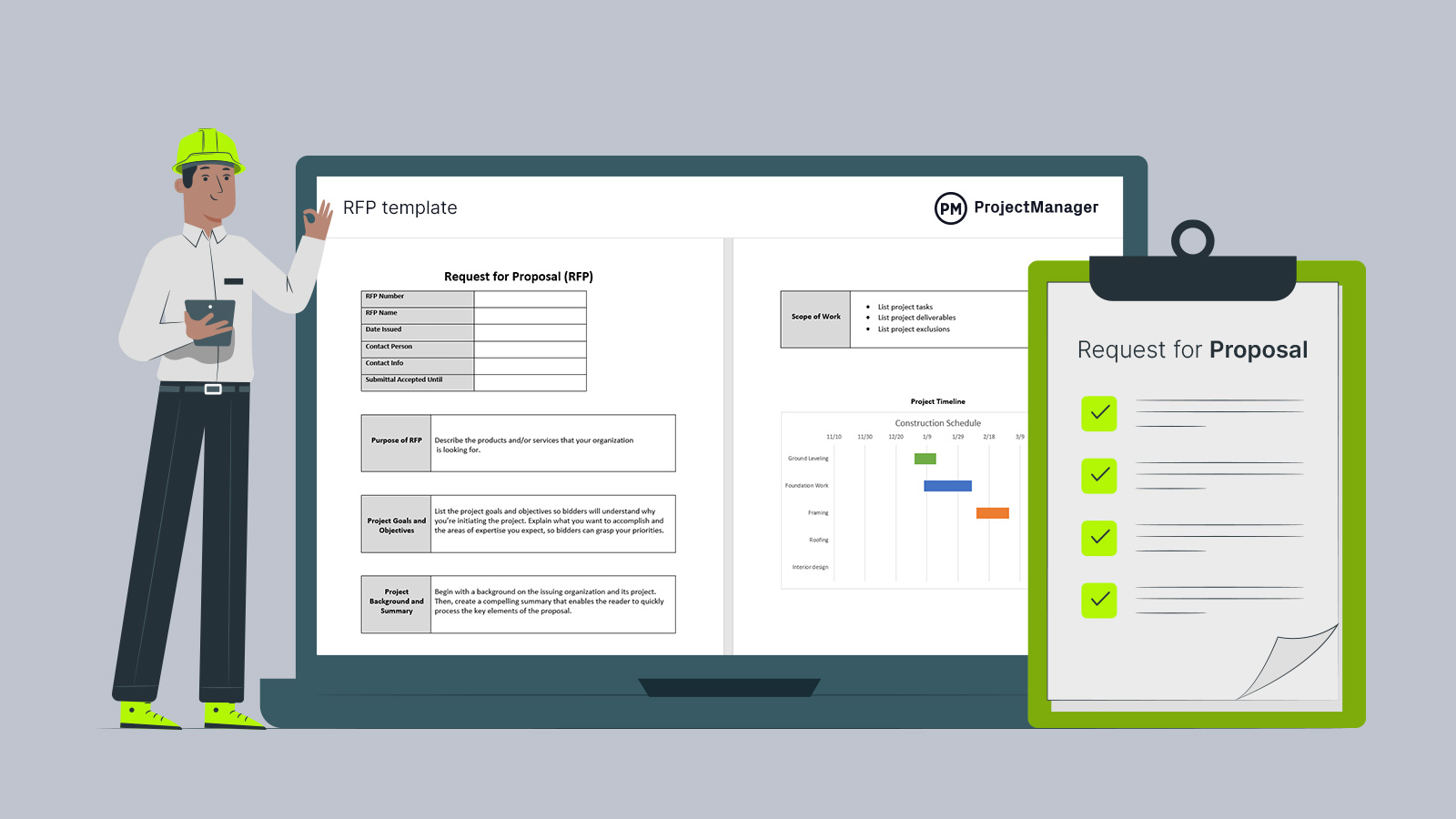
Get your free
RFP Template
Use this free RFP Template for Word to manage your projects better.
9. Engineer-Procure-Construct (EPC)
This common project delivery method is used in industries like energy, oil and gas. It’s used for large-scale and complex projects. They’re characterized by a single contractor taking responsibility for all project phases, from the initial design and engineering to the procurement of materials and equipment.
In many cases, EPC contracts are fixed-price or lump sum, so the contractor agrees to deliver the project for a pre-determined price. If there are variations, they need to be managed carefully.
Pros
- The owner only needs to manage one contract which streamlines project administration
- The fixed-price nature of most EPC contracts offers more cost certainty for the owner
- The integrated approach helps streamline the project and can potentially lead to faster completion
Cons
- The owner has less control over the design and construction process versus other delivery methods
- Disputes may arise if the scope of work isn’t clearly defined or if there are disagreements about performance
- Changes in project scope can be difficult and expensive when the contract is signed
10. Construction Management Multi-Prime (CMMP)
This is more of a unique construction project delivery method; it’s about giving the owner more control and trying to save costs as they take on the role of the general contractor. Instead of hiring a general contractor to manage the project, the owner directly hires multiple prime contractors for different aspects.
This could include separate contracts for roofing, plumbing, HVAC, electrical work, concrete, etc. In some cases, the owner may hire a construction manager to oversee and coordinate these prime contractors.
Pros
- The owner has direct control over choosing and managing each trade contractor, choosing the best fit for each job
- Helps the owner save money as they are negotiating directly with the trades
- The owner may get competitive bids from multiple contractors for each trade which can potentially reduce costs
Cons
- The owner takes on a significant administrative load and manages multiple contracts and schedules
- The owner assumes more risk as they are responsible for the project’s overall coordination and success
- Best suited for owners with expertise with significant construction knowledge
How to Choose a Construction Delivery Method
With so many construction delivery methods to choose from, how do you know the one that’s right for you? First, you must know what you’re building and why. But that’s only the start. You need more details in order to better choose a construction delivery method. To help guide you, look at the project budget, design, risks, schedule and owner’s expertise.
1. Make a Construction Budget
One of the more important parts of the project to settle on is the construction budget, so you’ll want to establish this as quickly as possible. You’ll also want to bring the design and construction team into the conversation to get their feedback on how realistic the budget you’ve come up with actually is.
Don’t forget to add some financial wiggle room to handle change orders that will inevitably come up during the build. Naturally, software costs will be part of the budget. Remember, these tools, including resource management tools, are upfront costs but are instrumental in reducing costs and speeding up the delivery of your project.
2. Create Architectural Drawings and Construction Documentation
It’s not enough to have a clear picture of what the structure you’re building looks like. You must also take into account the functionality of your building and create detailed architectural drawings and construction documentation. Is there a flow to your floor plan? Is the plan more innovative than functional? This is the point where you have to check your ambition against reality. It’s all well and good to have a complex design, but not if it’s going to interfere with the electrical system, plumbing or any other essential system.
Related: 8 Free Excel Construction Templates
3. Identify Potential Risks
Another consideration is construction risk. If there are too many risks, then the cost of the project could skyrocket and the whole endeavor could fail. Before you choose a construction delivery method, a thorough risk evaluation must be done long before committing to a project. Don’t neglect liability. For example, who will be responsible for design problems that result in dangerous situations on the job site and after construction is completed? The construction delivery methods need to be examined for liability and other risk factors.
4. Make a Construction Schedule
Then there’s your construction schedule. Having an accurate schedule is important, and schedule and project costs are closely linked. If you accelerate the schedule, costs will rise. You need to think about the timeline necessary to meet your expected schedule and costs. Do owners want you to fast-track the project before the completion of all construction drawings and documents? Is the schedule too ambitious, which leads to overrun and unhappy stakeholders? All of these variables will lead you to one construction delivery method over another.
The last piece in this puzzle is the owner. The owner can have a big impact on your project and the construction delivery method depending on their familiarity with construction and the job type. Are they used to working at this size and scope? Do they have the staff to oversee all of the processes involved? Owners can cause costly bottlenecks that lead to delays, so they must be a good fit for a successful project. The level of expertise might not make or break a project, but it will help you determine the right construction delivery method for the job.
Request for Proposal (RFP) Template
Choosing a project delivery method is one of most important things you’ll need to do before receiving, selecting and evaluating bids or project proposals from contractors. Then once you’re ready, you can use this free request for proposal template to gather all the information you need from bidders so you don’t miss any important details.
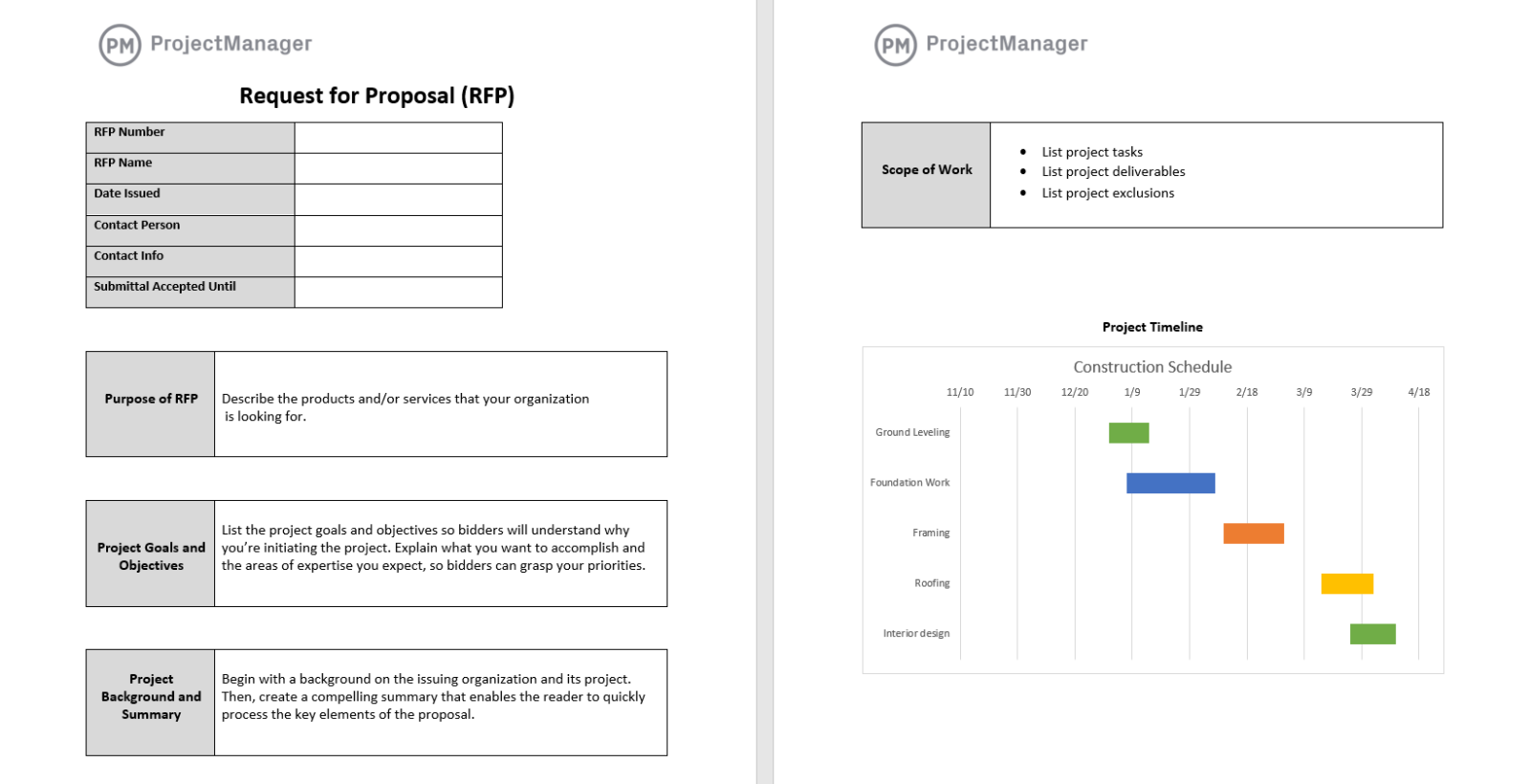
We offer a variety of free construction project management templates for Excel you can use to manage all aspects of your construction project.
ProjectManager Helps With Construction Project Delivery
Those are just some of the more common construction delivery methods, but all of them are improved by using project management software. ProjectManager is online construction project management software that connects all parties with real-time communication to facilitate collaboration. When you’re all working together on the same updated data, project success greatly improves.
Use the Tool You Want
Not only that, but designers, construction companies and owners aren’t always using the same tools, which is why we have multiple project views. Owners can look at calendars to make sure that milestones are being met. The general contractor can use interactive Gantt charts to organize tasks on a timeline and manage resource costs. Crews on site can check off tasks on robust list views that show the percentage complete while designers can visually track workflows on robust kanban boards. All views are updated simultaneously with real-time data so everyone is working with the same data.

Work Better Together
Yes, multiple project views are all updated together, but our online software also means that everyone in every team can connect whether they’re in the office, on-site or working remotely. We have unlimited file storage, which means all your construction documents and drawers are in a centralized hub that can be accessed by everyone. All files can be easily shared and teams can even comment at the task level or tag someone not assigned to that task and bring them into the conversation. Users get email notifications to keep them updated on changes, but there are also in-app alerts so you don’t have to leave the tool. Our collaborative platform connects everyone regardless of which construction delivery method you use.
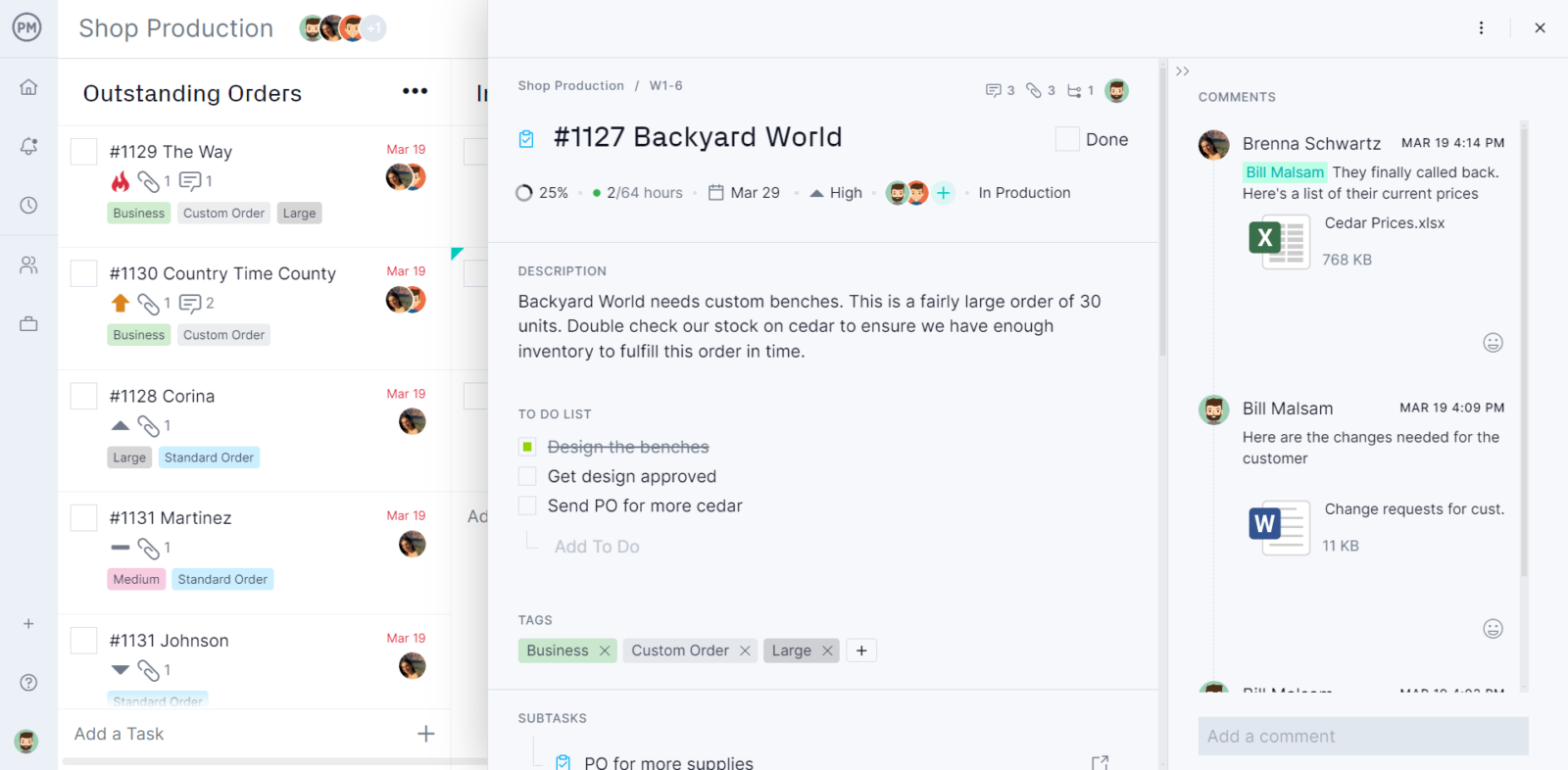
Our software can help plan, monitor and report on every phase of the construction project to keep everyone informed. Real-time dashboards give you a high-level view of six project metrics in easy-to-read graphs and charts. The data is collected, calculated and displayed automatically—there’s no setup like with lightweight tools. You can dive deeper into the data with customizable reports on status, cost, time and more, which can be shared with stakeholders to keep them updated. We’re your one-stop for all construction needs.
ProjectManager is award-winning construction software that can help you manage projects no matter which construction delivery method is right for you. Our real-time data means better collaboration and we have the features you need to control every aspect of the build, from initiation to closure. Get started with ProjectManager today for free.

